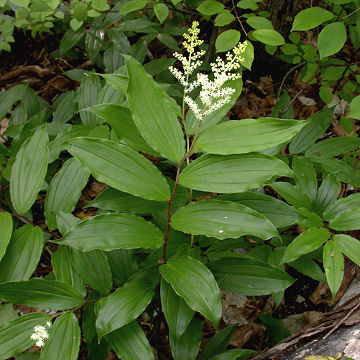

Maianthemum racemosum - (image 1 of 8)
Taxonomy
Family: Liliaceae
Habitat
Woods, dune woodlands.
Associates
In woods with Arisaema triphyllum, Botrychium virginianum, Circaea lutetiana canadensis, Claytonia virginica, Cryptotaenia canadensis, Galium aparine, Geranium maculatum, Osmorhiza claytonii, Podophyllum peltatum, Polygonatum canaliculatum, Sanicula gregaria, Smilax lasioneura, Trillium recurvatum.
Distribution
Most of our area
Morphology
Herbaceous perennial to 30" high. Leaves in 2 ranks, elliptic, to 6" long and 3" wide, obtuse or rounded at the base, short-acuminate, finely hairy beneath. Stems finely hairy, curved-ascending. Flowers numerous, on very short pedicels, to 1/8" wide, in a pedunculate to sessile terminal panicle; perianth segments up to 2 mm long, shorter than the stamens. Fruit dotted, becoming red at maturity, sometimes spotted with purple but not striped.
Notes
Flowers mid April to late June
Wetland indicator: Facultative upland
Formerly known as Smilacina racemosa (L.) Desf., it has been widely accepted that the two genera be merged based on the "pattern of inflorescence growth". It is also suggested that the proper family is now Ruscaceae. I have not read the paper by LaFrankie proposing the change.
The differences between the two genera appear to include the following:
Smilacina: Tepals 6; stamens 6; anthers ovate; ovary globose; style very short; stigma obscurely 3-lobed
Maianthemum: Tepals 4; stamens 4; anthers introrse; ovary bilocular, with a 2-lobed style
References
Dickinson, Tim. 2004. Maianthemum spp.
Botany Department, University of Toronto.
http://www.botany.utoronto.ca/courses/BOT307/D_Families/307D1Maianthemum.html
Gleason, Henry A. and A. Cronquist. 1991. Manual of Vascular Plants of
Northeastern United States
and Adjacent Canada. Second Ed.
The New York Botanical Garden. Bronx, NY
Swink, F. and G. Wilhelm. 1994. Plants of the Chicago Region.
Indiana Academy of Science. The Morton Arboretum. Lisle, Illinois.
|
Michael Hough © 2005 |